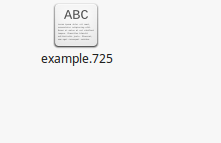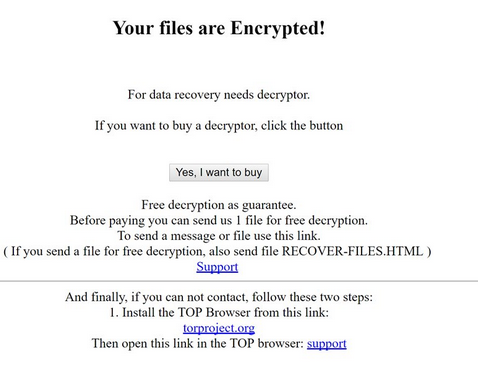Our complete .725 Virus removal guide hows how victims of the ransomware can recover their files. This is a malware that encrypts sensitive data with the .725 extension and extorts the victims for a ransomware payment.
Manual Removal Guide
Recover .725 Virus Files
Skip all steps and download anti-malware tool that will safely scan and clean your PC.
SpyHunter anti-malware tool will diagnose all current threats on the computer. By purchasing the full version, you will be able to remove all malware threats instantly. Additional information about SpyHunter / Help to uninstall SpyHunter
How Does .725 Virus Infiltrate the System?
The .725 Virus is being actively distributed to computer users worldwide using some of the most important tactics. One of the primary means is through spam email campaignsstrong>. The hackers send out mass messages that use social engineering tricks to confuse the users into infecting themselves with the .725 Virus. They may be of several different types:
- Empty Content ‒ Usually these messages use legitimate looking domains such as: Microsoft, Google, Yahoo, banks and etc. The malicious files are usually archives with random names. They may use a common prefix, examples include: P320342.zip, P1240333.zip, A104195, A010202 and others. The email attachments may be of different file types: .doc, .docx, .js, .exe, .bat, .vbs, .htm, .hta.
- Template Messages ‒ Such emails usually are constructed in a way to make the user infect themselves by interacting with a hyperlink or downloading a certain attached file. The infection is attained as soon as the users fall victim to the .725 virus.
Other infection methods the use of browser hijackers, they are malicious web browser extensions. Versions are made for the most popular applications: Mozilla Firefox, Google Chrome, Opera, Safari, Microsoft Edge and Internet Explorer. Upon installation the victims will find that important settings have been changed. Browser hijackers typically change the default home page, search engine and new tabs page to redirect the users to a hacker-controlled site. In addition they extract valuable information from the browsers including: cookies, history, bookmarks, form data, passwords and account credentials. They are relayed to the hacker operators. During the infection process the .725 virus can be downloaded and executed on the target machines.
The malware can also be distributed using infected software bundles. They are available on hacker-controlled download sites and popular P2P networks like BitTorrent. Depending on the case they may be customized copies of legitimate installers or the .725 ransomware virus binaries themselves.
Related: Mole00-02 Ransomware Virus, [email protected]].aleta Virus
Infection Flow of .725 Virus
The .725 Virus follows a ransomware behavior pattern that is similar to many other related threats. The initial security analysis shows that the malware does not feature any code from any of the famous malware families. This means that it is developed by an unknown hacker or criminal collective.
One of the first actions executed by the threat is the settings change done to the operating system. In order to make file recovery more difficult the virus engine deletes all shadow volume copies found on the compromised computer. File recovery is only possible by using a professional-grade data recovery solution.
The Windows registry may also be modified by the threat. Depending on the hacker configuration it may start in a persistent state. This means that the .725 virus engine can monitor user actions and actively modify the Windows registry to prevent manual removal attempts. In such cases the victims can only rely on a quality anti-spyware solution to remove the active infections.
Once the initial infection vectors are complete the ransomware module is launched. It starts to look out for certain file type extensions that are preconfigured by the hackers. Depending on the hacker attack it may be changed according to the targets. The collected .725 virus samples showcase that the following files are affected by the malware:
PNG .PSD .PSPIMAGE .TGA .THM .TIF .TIFF .YUV .AI .EPS .PS .SVG .INDD .PCT .PDF .XLR .XLS .XLSX .ACCDB .DB .DBF .MDB .PDB .SQL .APK .APP .BAT .CGI .COM .EXE .GADGET .JAR .PIF .WSF .DEM .GAM .NES .ROM .SAV CAD Files .DWG .DXF GIS Files .GPX .KML .KMZ .ASP .ASPX .CER .CFM .CSR .CSS .HTM .HTML .JS .JSP .PHP .RSS .XHTML. DOC .DOCX .LOG .MSG .ODT .PAGES .RTF .TEX .TXT .WPD .WPS .CSV .DAT .GED .KEY .KEYCHAIN .PPS .PPT .PPTX ..INI .PRF Encoded Files .HQX .MIM .UUE .7Z .CBR .DEB .GZ .PKG .RAR .RPM .SITX .TAR.GZ .ZIP .ZIPX .BIN .CUE .DMG .ISO .MDF .TOAST .VCD SDF .TAR .TAX2014 .TAX2015 .VCF .XML Audio Files .AIF .IFF .M3U .M4A .MID .MP3 .MPA .WAV .WMA Video Files .3G2 .3GP .ASF .AVI .FLV .M4V .MOV .MP4 .MPG .RM .SRT .SWF .VOB .WMV 3D .3DM .3DS .MAX .OBJ R.BMP .DDS .GIF .JPG ..CRX .PLUGIN .FNT .FON .OTF .TTF .CAB .CPL .CUR .DESKTHEMEPACK .DLL .DMP .DRV .ICNS .ICO .LNK .SYS .CFG
All affected files are renamed with the .725 extension.

When the process is complete a ransomware note is crafted in a RECOVER-FILES.HTML file. It contains the following message:
Your files are Encrypted!
For data recovery needs decryptor.
If you want to buy a decryptor, click the button
Yes, I want to buy
Free decryption as guarantee.
Before paying you can send us 1 file for free decryption.To send a message or file use this link.
( If you send a file for free decryption, also send file RECOVER-FILES.HTML )And finally, if you can not contact, follow these two steps:
1. Install the TOR Browser from this link:Then open this link in the TOR browser:

The displayed message extorts the victims to pay a ransomware fee by visiting a payment gateway located on the TOR hidden network. When the users visit the site they are shown additional instructions and the requested ransomware sum. The collected samples request the sum of 0.18 Bitcoins which is the equivalent of about 500 US Dollars.
Victims of the .725 virus and all other malware can rely on a quality anti-spyware removal tool that can remove active infections with only a few mouse clicks. Follow our instructions below to effectively protect yourself from danger and learn how to remove virus instances.
Remove .725 Virus and Restore Data
WARNING! Manual removal of .725 Virus requires being familiar with system files and registries. Removing important data accidentally can lead to permanent system damage. If you don’t feel comfortable with manual instructions, download a powerful anti-malware tool that will scan your system for malware and clean it safely for you.
SpyHunter anti-malware tool will diagnose all current threats on the computer. By purchasing the full version, you will be able to remove all malware threats instantly. Additional information about SpyHunter / Help to uninstall SpyHunter
.725 Virus – Manual Removal Steps
Start the PC in Safe Mode with Network
This will isolate all files and objects created by the ransomware so they will be removed efficiently. The steps bellow are applicable to all Windows versions.
1. Hit the WIN Key + R
2. A Run window will appear. In it, write msconfig and then press Enter
3. A Configuration box shall appear. In it Choose the tab named Boot
4. Mark Safe Boot option and then go to Network under it to tick it too
5. Apply -> OK
Show Hidden Files
Some ransomware threats are designed to hide their malicious files in the Windows so all files stored on the system should be visible.
1. Open My Computer/This PC
2. Windows 7
-
– Click on Organize button
– Select Folder and search options
– Select the View tab
– Go under Hidden files and folders and mark Show hidden files and folders option
3. Windows 8/ 10
-
– Open View tab
– Mark Hidden items option

4. Click Apply and then OK button
Enter Windows Task Manager and Stop Malicious Processes
1. Hit the following key combination: CTRL+SHIFT+ESC
2. Get over to Processes
3. When you find suspicious process right click on it and select Open File Location
4. Go back to Task Manager and end the malicious process. Right click on it again and choose End Process
5. Next, you should go folder where the malicious file is located and delete it
Repair Windows Registry
1. Again type simultaneously the WIN Key + R key combination
2. In the box, write regedit and hit Enter
3. Type the CTRL+ F and then write the malicious name in the search type field to locate the malicious executable
4. In case you have discovered registry keys and values related to the name, you should delete them, but be careful not to delete legitimate keys
Click for more information about Windows Registry and further repair help
Recover .725 Virus Files
WARNING! All files and objects associated with .725 Virus should be removed from the infected PC before any data recovery attempts. Otherwise the virus may encrypt restored files. Furthermore, a backup of all encrypted files stored on external media is highly recommendable.
DOWNLOAD .725 Virus Removal ToolSpyHunter anti-malware tool will diagnose all current threats on the computer. By purchasing the full version, you will be able to remove all malware threats instantly. Additional information about SpyHunter / Help to uninstall SpyHunter
1. Use present backups
2. Use professional data recovery software
Stellar Phoenix Data Recovery – a specialist tool that can restore partitions, data, documents, photos, and 300 more file types lost during various types of incidents and corruption.
3. Using System Restore Point
-
– Hit WIN Key
– Select “Open System Restore” and follow the steps

4. Restore your personal files using File History
-
– Hit WIN Key
– Type restore your files in the search box
– Select Restore your files with File History
– Choose a folder or type the name of the file in the search bar
– Hit the “Restore” button



